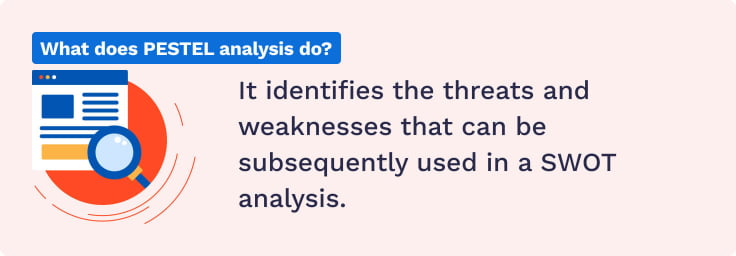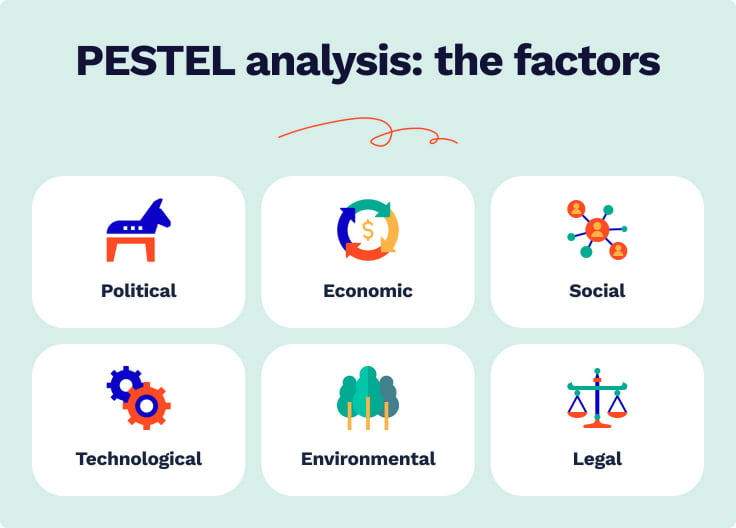👍 PESTEL Analysis Generator: the Benefits
Here are the key benefits of this PESTLE analysis generator.
| 👌 Easy to use | Follow the prompts & look at the examples. |
|---|---|
| 🦋 Adjustable | Choose the PESTEL template you like most. |
| 🌐 Online | You won’t need to download any software. |
| 🆓 No payments | 100% free, no sign-ups or hidden payments. |
📌 PESTLE Analysis Generator: How Does It Work?
- Fill in the online form of the PESTEL analysis maker by following the prompts.
- Add extra fields if necessary.
- Choose one of the PESTEL analysis templates in the design preview.
- Choose the color scheme in the left lower corner of the design preview.
- Choose the preferred file format.
- Download the result for free.
📊 PESTEL Analysis & Its Components
A PESTEL analysis provides a framework to monitor the macro level of the industrial environment that impacts a firm, organization, or the entire industry.

It identifies the threats and weaknesses that can be subsequently used in a SWOT analysis.
The 6 Factors of PESTEL Analysis Template
Below you’ll find a list of PESTEL analysis components.

-
Political factors:
- government policies and their changes;
- foreign trade policies;
- internal political problems;
- regulation and de-regulation trends.
-
Economic factors:
- current and expected economic development;
- Inflation;
- interest rates;
- job market and unemployment rates;
- labor costs;
- available infrastructure;
- impact of globalization.
-
Social factors:
- demographics (age, gender, race);
- nuclear family size as the basic social unit;
- attitudes and buying patterns of consumers;
- population growth rate;
- employment patterns;
- cultural changes;
- living standards.
-
Technological factors:
- new ways of production;
- new ways of distribution;
- new ways of communicating with clients and target markets.
-
Environmental factors:
- growing lack of raw materials;
- industrial pollution;
- building an ethical and sustainable business.
- carbon footprint.
-
Legal factors:
- healthcare and safety laws;
- providing equal opportunities for all people;
- consumer rights;
- advertising standards;
- tax policies;
- product labeling laws.
✅ 5 Reasons to Use PESTEL Templates
| They lead to meaningful conclusions |
This benefit will be the most helpful when a company plans to enter a new market, or an entrepreneur wants to launch a new venture. The analysis shows the state of things and allows you to draw your business into the existing background. But PESTEL analysis is critical for finding new opportunities and defining the weak points. Thus, it may become a trouble-shooting tool followed by a SWOT method. |
|---|---|
| They can be combined with other tools | As mentioned above, SWOT and Porter’s Five Forces analyses can be a logical continuation of the PESTEL diagram. When used in tandem, they will provide comprehensive and balanced recommendations for business development. |
| They help you develop a better understanding of the company | Although the tool is focused on external factors, it shows the bottlenecks and growth points of the company. They indicate the current opportunities within your organization. Meanwhile, one shouldn’t forget about the threats that can become fully comprehensible only after understanding the external factors. |
| They focus on making predictions | Any business development strategy considers external factors. You cannot develop without their systematic picture. This statement is even more important in the long-term perspective. |
| They help you get straightforward conclusions. | The tool allows for sifting out unnecessary information and making grounded decisions considering only the critical internal and external factors. Thus, you don’t disperse on dealing with non-critical issues and achieving weak purposes. |
📄 PESTEL Analysis Examples
Below you’ll find a collection of PESTEL essay examples that focus on various companies, industries, and even countries. We hope that you’ll get inspired by this list.
-
PESTEL Analysis of India: Political Factors
The paper analyzes the political characteristics of one of the world’s most powerful economies using PESTEL framework.
-
Drones Technology: PESTEL Analysis
The paper uses PESTEL analysis model to look at the drones technology. It examines various PESTEL factors to seek the best strategic marketing plan for establishing a drone business in Italy.
-
Virgin Media Company’s PESTEL Analysis
The paper analyzes Virgin Media, a British telecommunications company that provides telecommunication services in the United Kingdom.
-
BlackBerry Company’ PESTEL Analysis
The essay uses PESTEL framework to examine BlackBerry Limited, a Canadian company that specializes in cybersecurity and software.
-
PESTLE Analysis and the Resource-Based Theory
The paper focuses on PESTLE analysis and the resource-based theory. This strategic management theory suggests that resources that are valuable, rare, and difficult to imitate.
-
British Petroleum Company’s SWOT and BP PESTLE Analysis
The essay analyzes one of the world’s seven gas and oil "supermajors" headquartered in London. It uses both SWOT and PESTLE frameworks.
Thank you for reading this article! If you are interested in other business analysis options, consider trying our SOAR and VRIO analysis makers.
❓ PESTEL Analysis Creator FAQ
❓ Is It PESTEL or Pestle Analysis?
The abbreviations PESTEL or PESTLE denote the same analysis of external factors influencing an organization. These are political, economic, sociological, technological, legal, and environmental. The only difference is that ecological factors come before legal ones in PESTLE.
❓ What Does PESTEL Analysis Do?
A PESTEL analysis is a framework for strategically evaluating a company’s business environment. It unveils the threats and opportunities outside the management’s sphere of influence. Consequently, understanding the current factors helps businesses in strategic decision-making.
❓ How to Conduct a PESTEL Analysis?
- List the factors influencing the business in question.
- Define the implications of these factors by ranking or rating them.
- Rate the likelihood of each factor’s impact.
- Develop “what if” scenarios to make an action plan or proceed to SWOT analysis.
❓ What Is the Key Outcome from PESTEL Analysis?
The key outcome is the macro picture of the environment where the business currently exists. In other words, it is a diagram representing the factors that influence or might influence the company. They are divided into six categories (politics, economy, sociology, technology, environment, and legislation).